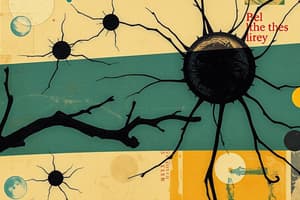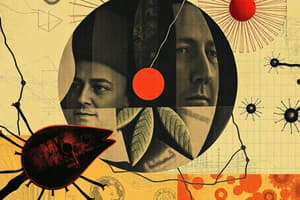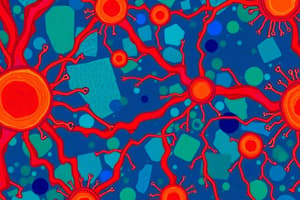Podcast
Questions and Answers
DAG and cAMP activate specific protein kinases within the cell.
DAG and cAMP activate specific protein kinases within the cell.
True (A)
IP3 decreases intracellular calcium concentration.
IP3 decreases intracellular calcium concentration.
False (B)
Enzyme-linked receptors cause a signal cascade effect like that caused by G protein–coupled receptors.
Enzyme-linked receptors cause a signal cascade effect like that caused by G protein–coupled receptors.
True (A)
The activation of intracellular receptors primarily targets structural proteins for function.
The activation of intracellular receptors primarily targets structural proteins for function.
Activated tyrosine kinase receptors can phosphorylate themselves and other specific proteins.
Activated tyrosine kinase receptors can phosphorylate themselves and other specific proteins.
The effects of drugs that activate intracellular receptors typically occur in minutes to hours.
The effects of drugs that activate intracellular receptors typically occur in minutes to hours.
Ligands interacting with intracellular receptors must have sufficient lipid solubility to diffuse into the cell.
Ligands interacting with intracellular receptors must have sufficient lipid solubility to diffuse into the cell.
Phosphorylation through enzyme-linked receptors does not modify the structure of target proteins.
Phosphorylation through enzyme-linked receptors does not modify the structure of target proteins.
Receptors that are internalized within the cell are said to undergo down-regulation.
Receptors that are internalized within the cell are said to undergo down-regulation.
During the refractory phase, receptors are highly responsive to agonist stimulation.
During the refractory phase, receptors are highly responsive to agonist stimulation.
Up-regulation of receptors occurs with repeated exposure to an agonist.
Up-regulation of receptors occurs with repeated exposure to an agonist.
The pharmacologic effect of a drug is not influenced by the concentration of the drug at the receptor site.
The pharmacologic effect of a drug is not influenced by the concentration of the drug at the receptor site.
A graded dose–response curve indicates that an increase in drug concentration will gradually increase the pharmacologic effect.
A graded dose–response curve indicates that an increase in drug concentration will gradually increase the pharmacologic effect.
Potency is determined by the amount of drug needed to produce a maximal effect.
Potency is determined by the amount of drug needed to produce a maximal effect.
EC50 is the measure of drug concentration at which 100% of the maximum effect is achieved.
EC50 is the measure of drug concentration at which 100% of the maximum effect is achieved.
Ion channel receptors have a finite recovery time before they can be activated again after stimulation.
Ion channel receptors have a finite recovery time before they can be activated again after stimulation.
Dihydrofolate reductase is a target of antimicrobials such as atorvastatin.
Dihydrofolate reductase is a target of antimicrobials such as atorvastatin.
Signal transduction involves the ability to amplify small signals.
Signal transduction involves the ability to amplify small signals.
The binding of albuterol lasts longer than the activated G proteins it generates.
The binding of albuterol lasts longer than the activated G proteins it generates.
Systems with spare receptors require most receptors to be occupied to elicit a maximal response.
Systems with spare receptors require most receptors to be occupied to elicit a maximal response.
Around 99% of insulin receptors are considered spare receptors.
Around 99% of insulin receptors are considered spare receptors.
Tachyphylaxis refers to the increased responsiveness of a receptor after repeated administration of an agonist.
Tachyphylaxis refers to the increased responsiveness of a receptor after repeated administration of an agonist.
Desensitization of receptors may be caused by excessive agonist stimulation.
Desensitization of receptors may be caused by excessive agonist stimulation.
Only about 5% to 10% of the total β-adrenoceptors in the heart are spare receptors.
Only about 5% to 10% of the total β-adrenoceptors in the heart are spare receptors.
The therapeutic index (TI) is calculated by dividing the effective dose (ED50) by the toxic dose (TD50).
The therapeutic index (TI) is calculated by dividing the effective dose (ED50) by the toxic dose (TD50).
A larger therapeutic index indicates a smaller margin between effective and toxic doses of a drug.
A larger therapeutic index indicates a smaller margin between effective and toxic doses of a drug.
Warfarin is an example of a drug with a large therapeutic index.
Warfarin is an example of a drug with a large therapeutic index.
Penicillin can be administered in higher doses without significant risk of adverse effects due to its large therapeutic index.
Penicillin can be administered in higher doses without significant risk of adverse effects due to its large therapeutic index.
Clinical trials and clinical experience are used to determine the therapeutic index of a drug.
Clinical trials and clinical experience are used to determine the therapeutic index of a drug.
Drugs with low therapeutic indices are never used in clinical practice.
Drugs with low therapeutic indices are never used in clinical practice.
Bioavailability is important in determining the therapeutic efficacy of drugs with low therapeutic indices.
Bioavailability is important in determining the therapeutic efficacy of drugs with low therapeutic indices.
The therapeutic index does not provide any information about a drug's safety.
The therapeutic index does not provide any information about a drug's safety.
A drug with a higher Kd value has a stronger affinity for its receptor.
A drug with a higher Kd value has a stronger affinity for its receptor.
The law of mass action states that the magnitude of the response is proportional to the number of receptors occupied by the drug.
The law of mass action states that the magnitude of the response is proportional to the number of receptors occupied by the drug.
Full agonists have an intrinsic activity value less than one.
Full agonists have an intrinsic activity value less than one.
Partial agonists can produce the same Emax as full agonists when all receptors are occupied.
Partial agonists can produce the same Emax as full agonists when all receptors are occupied.
Intrinsic activity can take on values between zero to infinity.
Intrinsic activity can take on values between zero to infinity.
A partial agonist may have an affinity that is equivalent to a full agonist despite its lower intrinsic activity.
A partial agonist may have an affinity that is equivalent to a full agonist despite its lower intrinsic activity.
The Emax occurs when all receptors are unoccupied by the drug.
The Emax occurs when all receptors are unoccupied by the drug.
A partial agonist may act as a partial antagonist of a full agonist.
A partial agonist may act as a partial antagonist of a full agonist.
If 1 mg of lorazepam produces the same anxiolytic response as 10 mg of diazepam, then lorazepam is more potent than diazepam.
If 1 mg of lorazepam produces the same anxiolytic response as 10 mg of diazepam, then lorazepam is more potent than diazepam.
Oxycodone is less efficacious than aspirin at producing analgesic effects.
Oxycodone is less efficacious than aspirin at producing analgesic effects.
In the presence of propranolol, epinephrine is less efficacious because a higher concentration is needed.
In the presence of propranolol, epinephrine is less efficacious because a higher concentration is needed.
Picrotoxin is a competitive antagonist based on its effect on diazepam's efficacy.
Picrotoxin is a competitive antagonist based on its effect on diazepam's efficacy.
Warfarin is a safer drug than penicillin because it has a small therapeutic index.
Warfarin is a safer drug than penicillin because it has a small therapeutic index.
The high therapeutic index of penicillin makes it safe for all patients.
The high therapeutic index of penicillin makes it safe for all patients.
Diazepam is more potent than picrotoxin based on their sedative effects.
Diazepam is more potent than picrotoxin based on their sedative effects.
Epinephrine acts as a noncompetitive antagonist when interacted with propranolol.
Epinephrine acts as a noncompetitive antagonist when interacted with propranolol.
Flashcards
What is the effect of DAG and cAMP?
What is the effect of DAG and cAMP?
DAG and cAMP activate specific protein kinases within the cell, leading to a variety of physiological effects.
What does IP3 do?
What does IP3 do?
IP3 increases intracellular calcium concentration, which in turn activates other protein kinases.
Enzyme-Linked Receptors: What's the Mechanism?
Enzyme-Linked Receptors: What's the Mechanism?
Enzyme-linked receptors undergo conformational changes upon ligand activation, resulting in increased intracellular enzyme activity.
What's the most common enzyme-linked receptor?
What's the most common enzyme-linked receptor?
Signup and view all the flashcards
What's the role of phosphorylation in enzyme-linked receptors?
What's the role of phosphorylation in enzyme-linked receptors?
Signup and view all the flashcards
Describe the signal cascade effect of enzyme-linked receptors.
Describe the signal cascade effect of enzyme-linked receptors.
Signup and view all the flashcards
What distinguishes intracellular receptors?
What distinguishes intracellular receptors?
Signup and view all the flashcards
What's the primary function of activated intracellular receptors?
What's the primary function of activated intracellular receptors?
Signup and view all the flashcards
Signal Transduction
Signal Transduction
Signup and view all the flashcards
Signal Amplification
Signal Amplification
Signup and view all the flashcards
Spare Receptors
Spare Receptors
Signup and view all the flashcards
Desensitization
Desensitization
Signup and view all the flashcards
Tachyphylaxis
Tachyphylaxis
Signup and view all the flashcards
Down-Regulation
Down-Regulation
Signup and view all the flashcards
Dihydrofolate Reductase (DHF Reductase)
Dihydrofolate Reductase (DHF Reductase)
Signup and view all the flashcards
G Proteins
G Proteins
Signup and view all the flashcards
Receptor Down-Regulation
Receptor Down-Regulation
Signup and view all the flashcards
Refractory Period
Refractory Period
Signup and view all the flashcards
Receptor Up-Regulation
Receptor Up-Regulation
Signup and view all the flashcards
Agonist
Agonist
Signup and view all the flashcards
Graded Dose-Response Relationship
Graded Dose-Response Relationship
Signup and view all the flashcards
Potency
Potency
Signup and view all the flashcards
EC50
EC50
Signup and view all the flashcards
Efficacy
Efficacy
Signup and view all the flashcards
Kd and drug affinity
Kd and drug affinity
Signup and view all the flashcards
Law of Mass Action and drug response
Law of Mass Action and drug response
Signup and view all the flashcards
Intrinsic activity: Full agonist
Intrinsic activity: Full agonist
Signup and view all the flashcards
Intrinsic activity: Partial agonist
Intrinsic activity: Partial agonist
Signup and view all the flashcards
Partial agonist as antagonist?
Partial agonist as antagonist?
Signup and view all the flashcards
Intrinsic activity: Inverse agonist
Intrinsic activity: Inverse agonist
Signup and view all the flashcards
Agonist vs. antagonist
Agonist vs. antagonist
Signup and view all the flashcards
Competitive Antagonist
Competitive Antagonist
Signup and view all the flashcards
Non-Competitive Antagonist
Non-Competitive Antagonist
Signup and view all the flashcards
Therapeutic Index
Therapeutic Index
Signup and view all the flashcards
Full Agonist
Full Agonist
Signup and view all the flashcards
Partial Agonist
Partial Agonist
Signup and view all the flashcards
Pharmacodynamics
Pharmacodynamics
Signup and view all the flashcards
Therapeutic Index (TI)
Therapeutic Index (TI)
Signup and view all the flashcards
What does a high therapeutic index mean for a drug?
What does a high therapeutic index mean for a drug?
Signup and view all the flashcards
What's the significance of a low therapeutic index?
What's the significance of a low therapeutic index?
Signup and view all the flashcards
How is the therapeutic index determined?
How is the therapeutic index determined?
Signup and view all the flashcards
What's an example of a drug with a low therapeutic index?
What's an example of a drug with a low therapeutic index?
Signup and view all the flashcards
What's an example of a drug with a high therapeutic index?
What's an example of a drug with a high therapeutic index?
Signup and view all the flashcards
How does bioavailability affect therapeutic effects?
How does bioavailability affect therapeutic effects?
Signup and view all the flashcards
Why does bioavailability not critically affect therapeutic effects for high TI drugs?
Why does bioavailability not critically affect therapeutic effects for high TI drugs?
Signup and view all the flashcards
Study Notes
Drug-Receptor Interactions and Pharmacodynamics
- Pharmacodynamics describes how drugs affect the body.
- Most drugs exert effects by interacting with specialized target macromolecules called receptors.
- Drug-receptor complexes initiate alterations in biochemical and/or molecular activity, leading to a biological response via signal transduction.
- Receptors exist in inactive (R) and active (R*) states in reversible equilibrium.
- Agonists shift the equilibrium from R to R*.
- Partial agonists shift the equilibrium from R to R*, but to a lesser extent than full agonists.
- Antagonists bind to the receptor but do not increase the fraction of R*.
- Receptors can be divided into four families: ligand-gated ion channels, G protein-coupled receptors, enzyme-linked receptors, and intracellular receptors.
- Hydrophilic ligands interact with receptors on the cell surface, while hydrophobic ligands interact with intracellular receptors.
- Signal transduction demonstrates signal amplification and mechanisms to protect cells from excessive stimulation.
- The magnitude of the cellular response is proportional to the number of drug-receptor complexes.
- Specific types of receptors can affect different parts of the body.
- For instance, cardiac cells have receptor types that bind and respond to different neurotransmitters (like epinephrine or acetylcholine).
Overview
- Unoccupied receptors do not influence intracellular processes.
- Receptor activation changes its physical and chemical properties leading to interaction with other cellular molecules, producing a biological response.
Signal Transduction
- Drugs act as signals, and receptors act as signal detectors.
- Agonists bind and activate receptors, initiating a series of reactions leading to a specific intracellular response.
- Second messenger molecules translate agonist binding into a cellular response.
- Cells have various receptors that are specific for particular agonists and produce unique responses.
Receptor States
- Receptors exist in at least two states: inactive (R) and active (R*).
- The equilibrium usually favors the inactive state.
- Agonists shift the equilibrium from R to R*, producing a biological effect.
- Antagonists stabilize the inactive state (R), preventing agonist action.
Major Receptor Families
- Receptors are biological molecules to which drugs bind and produce a measurable response.
- Enzymes, nucleic acids, and structural proteins can act as receptors.
- Membrane-bound proteins are the richest source of receptors, transducing extracellular signals into intracellular responses.
Transmembrane Ligand-Gated Ion Channels
- The extracellular portion of ligand-gated ion channels contains the drug-binding site.
- This site regulates the opening of the pore through which ions can flow across cell membranes.
- Drug binding opens the channel for a few milliseconds, allowing ions to pass, mediating neurotransmission or muscle contraction.
Transmembrane G Protein-Coupled Receptors
- The extracellular portion contains the ligand-binding site.
- The intracellular portion interacts (when activated) with a G protein.
- G proteins are composed of three protein subunits: α, β, and γ.
- The α subunit binds GTP (guanosine triphosphate).
- The β and γ subunits anchor the G protein in the cell membrane.
- Agonist binding elevates GTP binding to the α subunit and causes dissociation of the α-GTP complex from the βγ complex, initiating intracellular pathways involving effector proteins.
Enzyme-linked Receptors
- These receptors change conformation upon ligand activation, increasing intracellular enzyme activity.
- Responses last from minutes to hours.
- Common types of enzyme-linked receptors have tyrosine kinase activity, which results in phosphorylation of tyrosine residues on the receptor itself and other proteins within the cell.
- Phosphorylation often modifies the structure of the target protein, acting as a molecular switch, triggering downstream signaling cascades affecting cell functions.
Intracellular Receptors
- Intracellular receptors are primarily located within the cell.
- Ligands must diffuse into the cell, making appropriate lipid solubility is necessary.
- Activating intracellular receptors typically involves changes within the nucleus
- Effects of drugs acting on intracellular receptors take hours to days to occur..
Dose-Response Relationships
- Agonists mimic endogenous ligands, and drug effect depends on receptor sensitivity and concentration.
- Graded dose-response curves illustrate how the effect of a drug changes with increasing dosages.
- Drug potency (EC50) measures the effectiveness of a dose to cause a response.
- Drug efficacy measures the maximum possible effect for a given drug.
Intrinsic Activity
- The ability of an agonist to activate a receptor and produce a cellular response can be categorized based on its intrinsic activity.
- A full agonist fully activates the receptor, mimicking the maximal response induced by the endogenous ligand.
Partial Agonists
- Full agonists produce a maximal response, partial agonists have intrinsic activities between zero and one.
- Even if all receptors are occupied, partial agonists do not elicit the same maximum response as full agonists.
- A partial agonist may act as an antagonist to other agonists.
Inverse Agonists
- Inverse agonists have intrinsic activity below zero and stabilize the inactive receptor form.
- These reduce the number of activated receptors, producing an effect opposite that of an agonist.
Antagonists
- Antagonists bind to receptors but do not produce a biological response themselves.
-Competitive antagonists bind to the same site as agonists, and their presence shifts the dose-response curve to the right.
- Irreversible antagonists bind to the receptors in a manner that inhibits further activation by agonists.
- Allosteric antagonists bind to a different site and decrease the receptor's ability to be activated by agonists.
Quantal Dose-Response Relationships
- In this relationship, the drug dose is associated with the proportion of a population that responds.
- The therapeutic index (TI) is the ratio of the dose of a drug that produces a toxic effect to the dose that causes the desired effect.
Studying That Suits You
Use AI to generate personalized quizzes and flashcards to suit your learning preferences.
Related Documents
Description
Test your understanding of cell receptors and their roles in signal transduction with this quiz. Explore how different receptors such as enzyme-linked and intracellular receptors operate, and the effects of various ligands and drugs on these processes. Aimed at students studying pharmacology and cell biology.




